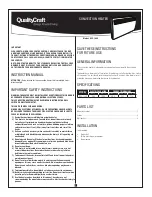
Direct Gas Make-Up Air
34
Typical settings are 0.0 in. wg (0 kPa). for the lower
pressure setting and 0.10 in. wg (0.02 kPa). for the
upper pressure setting. The needle indicates a negative
building pressure. During correct operation, the
indicating needle will remain between or near the setting
needles.
External Signal
A VFD is controlled according to input from an external
2-10 VDC or 4-20 mA signal (by others).
A 2 VDC or 4 mA signal will send the fan to low speed.
The fan will go to maximum speed with a 10 VDC or
20 mA signal.
Variable Kitchen Control
A VFD is controlled by input from a speed control signal
from the kitchen hood. This unit allows automatic
adjustment of make-up air volumes based on varying
cooking loads.
Burner Bypass Damper
The self-adjusting burner bypass damper is required for
proper operation of variable volume units. It functions
to maintain proper combustion by providing a constant
airflow over the burner when outside air volumes are
changed. It is located adjacent to the burner.
Outside Air
Supply Air
Burner Bypass
Damper
At design airflow, the bypass damper will be nearly open
and approximately 50% of the total airflow will pass
through the damper. The remaining air will pass over
the burner. As the supply airflow is reduced, the bypass
damper will begin to close. This reduces the amount
of air passing through the damper and maintains a
constant volume of air passing over the burner. At
Complete the
Supply Fan Pre-Start Checks and
Start-Up
sections in this Installation, Operation and
Maintenance Manual before proceeding.
For maintenance issues associated with a variable
frequency drive (VFD), consult the drive’s manual
supplied with the unit. The drives are programmed
at the factory and rarely need any adjustment during
installation and start-up. For kitchen applications, the
drive may be located in the kitchen or in the unit.
The VAV option is recommended when a building’s
exhaust volume may vary. This option enables the
make-up air volume to track the exhaust volume,
providing only the amount of make-up air required.
Control strategies include 2-speed and modulating
options. Before the unit is left in service, test the
variable air volume control system.
2-Speed Option
A VFD is used on a single speed motor to control air
volumes. The VFD is factory programmed for 2 speed
operation and can be switched to low or high speed
from a remote control panel. Turn the fan speed switch
on the remote control panel to each position and
confirm that the fan speed adjusts accordingly.
Modulating Options
Potentiometer Control
A VFD is controlled by input
from a remote speed selector
(potentiometer). This option allows
easy manual adjustment of make-up
air volumes.
To test potentiometer operation,
turn the potentiometer to the two
extremes. Make sure the fan goes
to maximum and minimum speed.
When the potentiometer is at
minimum, the fan speed will be at its
minimum. When the potentiometer
is at maximum, the fan will be at its
maximum speed.
Building Pressure Control
A VFD is controlled according to input
from a pressure sensing device.
On the Photohelic
®
gauge, turn both
pressure knobs to the upper most
setting. The VAV system should go
to maximum speed. Set both knobs
at the lowest setting and the VAV
system should go to minimum speed.
Reset the correct pressure limits
before starting the unit.
Start-Up: Direct Gas-Fired Heating
Optional Features
EXHAUST
(OPTIONAL)
(OPTIONAL)
55
60
65
70
75
80
85
90
SUPPLY
HEAT
DIRTY FILTERS
MAIN VALVES
BLOWERS
Potentiometer
Control
70
65
75
80
85
90
60
55
(OPTIONAL)
BLOWER
DIRTY FIL TERS
MAIN V AL VES
EXHAUST
SUPPL Y
HEA T
(OPTIONAL)
PHOTOHELIC
Building Pressure
Control
Variable Air Volume (VAV)
Photohelic
®
Gauge
Pressure Indicating
Needle
Pressure Setting
Needles
Pressure Setting Knobs
















































